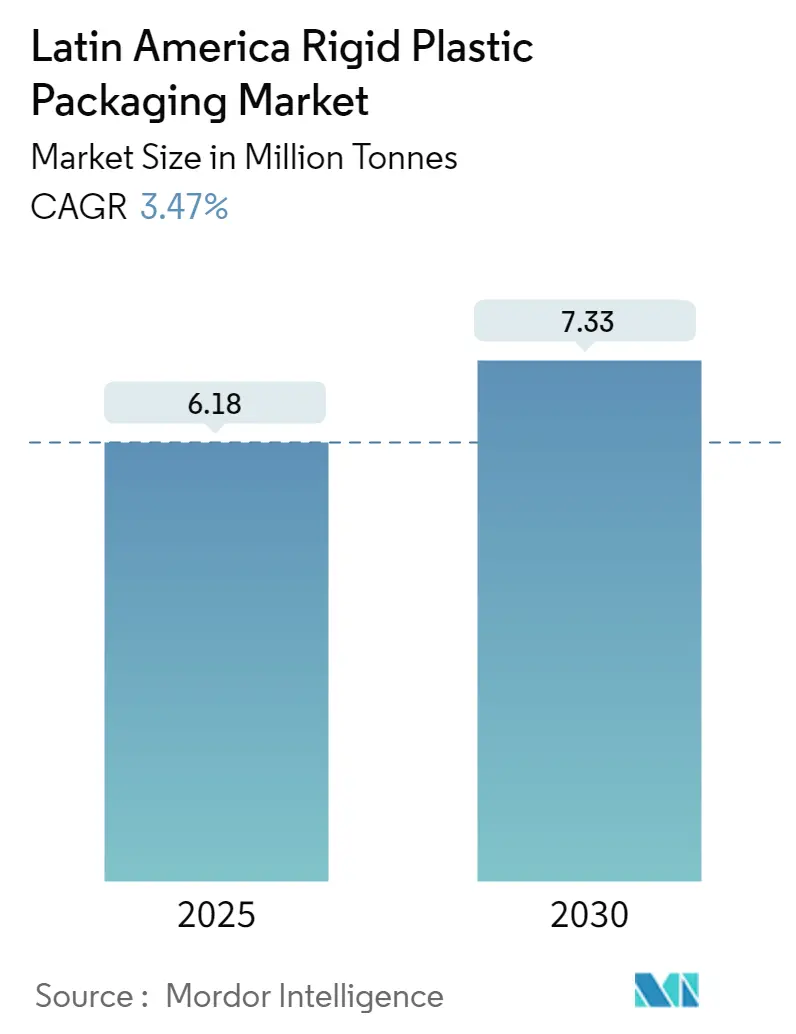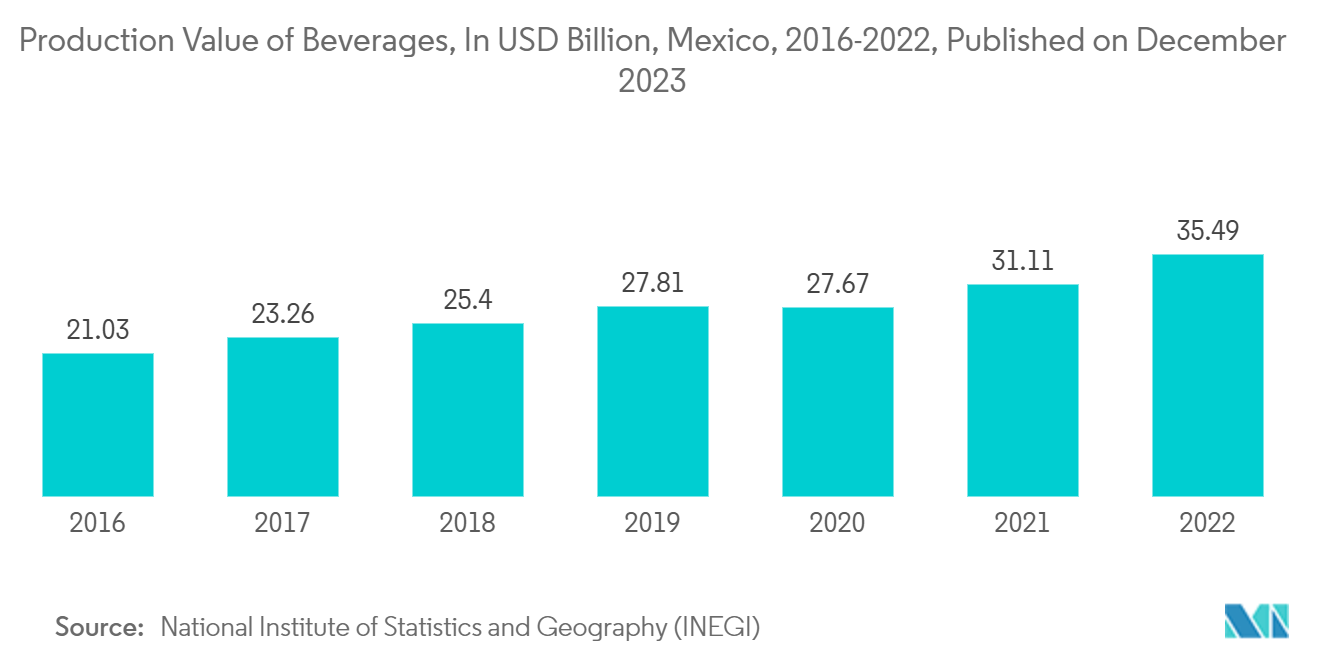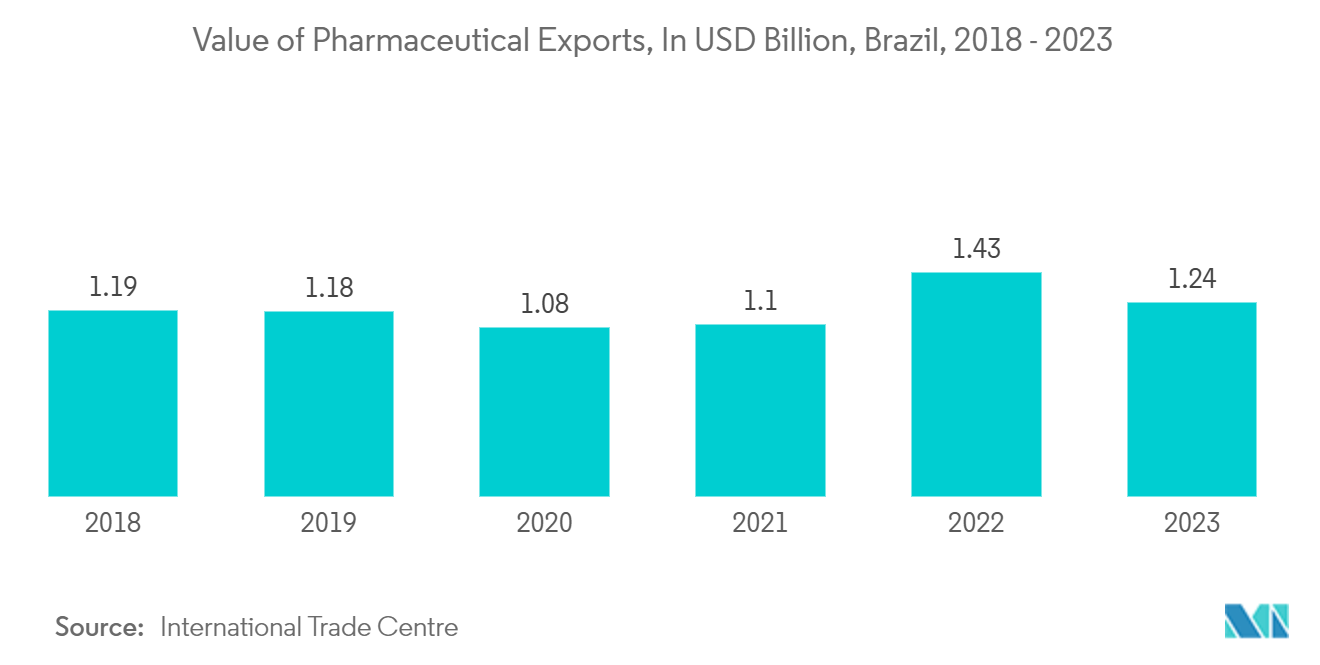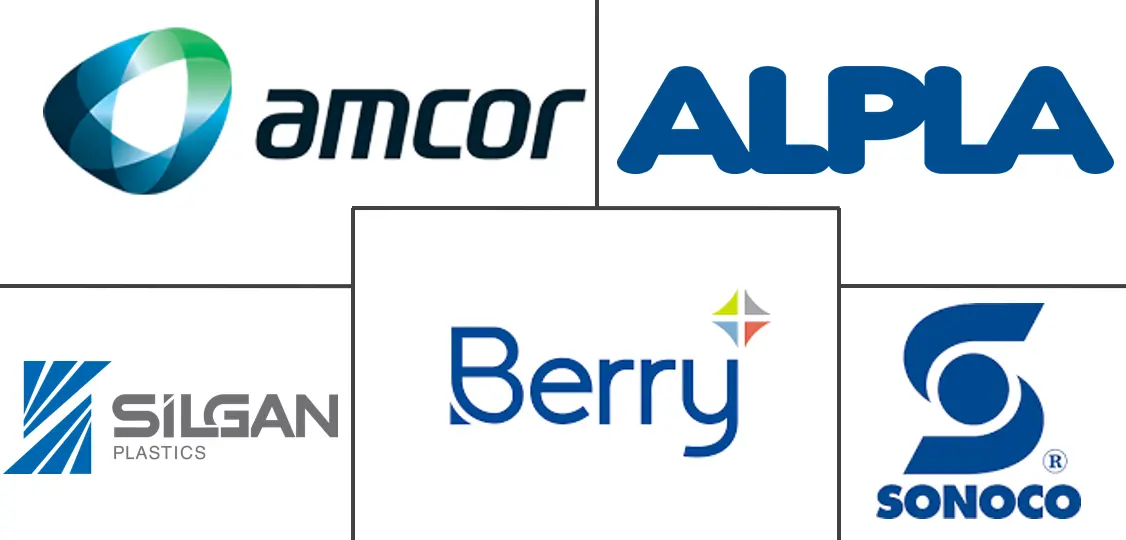Latin America Rigid Plastic Packaging Market Size and Share

Latin America Rigid Plastic Packaging Market Analysis by Mordor Intelligence
The Latin America Rigid Plastic Packaging Market size is estimated at 6.18 million tonnes in 2025, and is expected to reach 7.33 million tonnes by 2030, at a CAGR of 3.47% during the forecast period (2025-2030).
- The packaging industry has experienced consistent growth in recent years, propelled by shifts in substrate preferences, expanding markets, and evolving ownership structures. Sustainability and environmental concerns are set to maintain prominence, with the market witnessing several innovations tailored to plastic packaging. Notably, the consumption of recyclable plastic packaging is rising, which may lead to a greater demand for recyclable, sustainable packaging materials such as recycled PET and bioplastic packaging.
- The food industry is a pivotal force in shaping the packaging landscape within Brazil, a trend further accentuated by the prevalent work-from-home culture. Plastics dominate the food sector and are prized for their lightness, cost-effectiveness, and design adaptability. Their ease of use and storage make them a preferred choice, especially given their ability to extend product shelf life without the need for refrigeration, all while boasting eco-friendly attributes.
- Regional recycling firms are actively combatting plastic usage. For instance, TriCiclos has set ambitious targets to collect approximately 11,000 metric tons of plastic by 2025 across Brazil, Chile, Peru, and Colombia. Similarly, Boomera has established over 200 collection points for plastic waste across Brazil.
- Compared to their flexible counterparts, rigid plastic packaging employs denser and sturdier materials, providing enhanced structural integrity and support to the products they encase. Renowned for their durability, rigid plastic packages offer superior resistance to impacts, moisture, and other environmental factors, making them a preferred choice across various product categories.
- In response to escalating plastic pollution, Latin American governments are enacting policies aimed at curbing plastic waste and championing sustainable packaging. While these initiatives are well-intentioned, they have limited the region's market dynamics. The detrimental impact of plastic on the environment is now widely acknowledged, with heightened awareness spanning both consumers and the broader industry.
- Governments have rolled out a series of public campaigns and initiatives to further bolster this awareness. With mounting concerns over plastic pollution, there is a noticeable shift: manufacturers and consumers are leaning toward alternative packaging materials that prioritize environmental friendliness and introduce innovative solutions.
Latin America Rigid Plastic Packaging Market Trends and Insights
Food and Beverage Occupies the Largest Market Share
- The demand for aluminum cans, particularly for beverages, remains robust. An empty aluminum can typically weighs around 14.9 g. However, despite their lightweight nature, aluminum beverage cans face a higher risk of damage during import and export processes than their plastic bottle counterparts. This vulnerability has bolstered the preference for lightweight plastic materials in the production of bottles and containers.
- Latin America's growing inclination toward plastics can be attributed to their lightweight nature. In contrast, glass, being significantly heavier, necessitates more transport trips, amplifying its environmental footprint. While glass poses a heftier challenge for consumers, making it cumbersome to carry, the lightweight nature of plastic offers undeniable convenience. Additionally, end users are increasingly favoring lightweight plastic bottles and containers, aligning with a broader goal of enhancing the carbon dioxide ratio for sustainable manufacturing.
- With a rising number of value-oriented consumers in Brazil's food service industry, there is a notable trend toward exploring diverse culinary offerings, both local and international. This shift is fueled by a heightened frequency of dining out, reflecting changing dietary habits influenced by global cultures. Operators, recognizing this, are diversifying their menus to cater to these evolving tastes. In this landscape, rigid plastic packaging stands out for its durability, user-friendliness, and ability to uphold food quality.
- As Brazil's disposable income climbs and e-commerce flourishes, driven by a surging demand for various products, the nation is poised for significant growth. This growth is boosting the e-commerce sector and spurring the development of packaging manufacturers in the region. PET packaging, known for its strength, recyclability, versatility, and cost-efficiency, is becoming the go-to choice for safeguarding and transporting a wide array of products, further fueling its adoption in Brazil.
- According to an article published by INEGI in December 2023, beverage production in Mexico generated close to USD 35.49 billion in 2022, up from approximately USD 4.38 billion recorded a year earlier.
- With the increase in beverage production, there will be a growing emphasis on sustainability. Beverage companies are likely to demand eco-friendly packaging solutions, pushing rigid plastic packaging manufacturers to innovate in recyclable and biodegradable materials, enhancing the sustainability profile of the industry in Latin America.

Brazil to Account for Significant Market Growth
- Retailers often prioritize product presentation and branding to attract consumers and differentiate themselves from competitors. Food plastic packaging plays a crucial role in enhancing the visual appeal of packaged food products and communicating branding messages. As the retail industry grows, there may be an increased focus on innovative and attractive food plastic packaging solutions to capture consumer attention.
o Brazil's retail sector experienced substantial growth, achieving USD 134.8 billion in sales in 2022, as the United States Department of Agriculture reported in June 2023. This expansion was driven by a nationwide network of over 94,706 retail outlets, encompassing physical and virtual formats. Notably, the sector contributed approximately 7% to Brazil's Gross Domestic Product (GDP). - The Organic Trade Association indicates that in 2022, Brazil's consumption value of organic beverages accounted for USD 36.1 million. This country's consumption of organic liquids was projected to reach USD 38.1 million in the following year and USD 51.7 million by 2025. Organic beverages are frequently marketed as a healthier and more environmentally friendly alternative.
- This could lead to brands wanting to differentiate themselves through unique and eco-friendly packaging designs. Plastic manufacturers may have to innovate and provide packaging solutions compatible with the environmental values of agricultural products, for example, through recycling materials, biodegradable plastics, or more sustainable packaging forms.
- According to the International Trade Centre, in 2023, Brazil exported approximately USD 1.24 billion of pharmaceutical products, an increase from USD 1.1 billion of pharmaceutical exports reported in 2021.
- As Brazil's pharmaceutical exports grow, the need for packaging materials, including rigid plastic packaging, will increase. Pharmaceuticals require reliable and secure packaging solutions to ensure product integrity during transportation and storage, driving demand for high-quality rigid plastic packaging.

Competitive Landscape
The rigid plastic packaging market in Latin America is fragmented. Some leading players in the Latin American market are Amcor Group GmbH, Berry Global Inc., Plastipak Holding, Inc., and Silgan Holdings Inc. Major players with a significant presence in the market are diversifying their customer base into different regions. Additionally, many companies are engaging in strategic and collaborative partnerships with other companies to expand their market presence and profitability.
- May 2024: ALPLA, a plastic packaging specialist, launched a recyclable wine bottle crafted from polyethylene terephthalate (PET). This innovation slashes carbon footprints by 50% and offers up to 30% cost savings.
- May 2023: Amcor announced its flexible manufacturing plant in Londrina, Brazil. The Amcor facility in Latin America attained the prestigious International Sustainability and Carbon Certification Plus (ISSC Plus) status. This milestone empowers one of Amcor's key Latin American plants to integrate cutting-edge recycled materials into its diverse product range.
Latin America Rigid Plastic Packaging Industry Leaders
-
Berry Global Inc.
-
Silgan Holdings Inc.
-
Sonoco Products Company
-
Amcor Group GmbH
-
Alpla Werke Alwin Lehner GmbH & Co KG
- *Disclaimer: Major Players sorted in no particular order

Recent Industry Developments
- June 2024: Method, a producer of environmentally conscious cleaning and personal care items, announced a significant shift: all its transparent plastic bottles are crafted entirely from 100% recycled coastal plastic. This move stems from a strategic alliance with SC Johnson and Plastic Bank. Since 2018, SC Johnson, in tandem with Plastic Bank, has overseen the inception of over 550 plastic collection sites, notably in nations like Indonesia, the Philippines, Thailand, and Brazil.
- August 2023: Indorama Ventures, a player in the production of recycled PET (rePET) resin, extended its recycling operations in Brazil by investing USD 20 million to modernize the facility's operations and purchase new equipment, including washing machines, to facilitate the removal of labels, the grinding of bottles in water, and a 70% reduction in water consumption.
- May 2023: Greenback claimed to have completed the recycling cycle with its first state-of-the-art plastic recycling facility, which was set to commence operations in collaboration with Nestle, located in the Mexican city of Cuautla. The recycling technology is designed to circularize non-recyclable plastics and trace the origin of the material.
Latin America Rigid Plastic Packaging Market Report Scope
Rigid plastic packaging is defined as a type with heavier and often stronger materials than flexible plastic packaging. A rigid plastic package, which has been known for its strength, offers structure and support to the product. It is applied in various products, offering advantages like resistance to impact, moisture, and different environmental factors.
The Latin American rigid plastic packaging market is segmented by product (bottles and jars, trays and containers, and caps and closures), material (polyethylene [PE], polyethylene terephthalate [PET], polypropylene [PP], polystyrene [PS] and expanded polystyrene [EPS], and polyvinyl chloride [PVC]), end-user industry (food and beverage, healthcare, cosmetics and personal care, industrial, building and construction, automotive, and other end-user industries), and country (Brazil, Argentina, Mexico, and Rest of Latin America). The market sizes and forecasts are provided in terms of value (USD) for all the above segments.
| Polyethylene (PE) | LDPE and LLDPE |
| HDPE | |
| Polyethylene terephthalate (PET) | |
| Polypropylene (PP) | |
| Polystyrene (PS) and Expanded polystyrene (EPS) | |
| Polyvinyl chloride (PVC) | |
| Other Resins (Bioplastics, Polyamide (PA), Polycarbonate (PC), and Ethylene vinyl alcohol (EVOH), among Others) |
| Bottles and Jars |
| Trays and Containers |
| Caps and Closures |
| Intermediate Bulk Containers (IBCs) |
| Drums |
| Pallets |
| Other Product Types (Blisters and Clamshell Packs, Rigid Plastic Tubes, and Pails among Others) |
| Food** | Candy and Confectionery |
| Frozen Foods | |
| Fresh Produce | |
| Dairy Products | |
| Dry Foods | |
| Meat, Poultry, and Seafood | |
| Pet Food | |
| Other Food Products (Seasonings and Spices, Spreadables, Sauces, Condiments, etc.) | |
| Foodservice** | Quick Service Restaurants (QSRs) |
| Full-Service Restaurants (FSRs) | |
| Coffee and Snack Outlets | |
| Retail Establishments | |
| Institutional | |
| Hospitality | |
| Other Foodservice | |
| Beverage | |
| Healthcare | |
| Cosmetics and Personal Care | |
| Industrial (Chemical, Agriculture, and Oil & Lubricants, among Others) | |
| Building and Construction | |
| Automotive | |
| Other End-user Industries (Household Products, and Logistics, among Others) |
| Brazil |
| Mexico |
| Colombia |
| By Resin | Polyethylene (PE) | LDPE and LLDPE |
| HDPE | ||
| Polyethylene terephthalate (PET) | ||
| Polypropylene (PP) | ||
| Polystyrene (PS) and Expanded polystyrene (EPS) | ||
| Polyvinyl chloride (PVC) | ||
| Other Resins (Bioplastics, Polyamide (PA), Polycarbonate (PC), and Ethylene vinyl alcohol (EVOH), among Others) | ||
| By Product Type | Bottles and Jars | |
| Trays and Containers | ||
| Caps and Closures | ||
| Intermediate Bulk Containers (IBCs) | ||
| Drums | ||
| Pallets | ||
| Other Product Types (Blisters and Clamshell Packs, Rigid Plastic Tubes, and Pails among Others) | ||
| By End-user Industry | Food** | Candy and Confectionery |
| Frozen Foods | ||
| Fresh Produce | ||
| Dairy Products | ||
| Dry Foods | ||
| Meat, Poultry, and Seafood | ||
| Pet Food | ||
| Other Food Products (Seasonings and Spices, Spreadables, Sauces, Condiments, etc.) | ||
| Foodservice** | Quick Service Restaurants (QSRs) | |
| Full-Service Restaurants (FSRs) | ||
| Coffee and Snack Outlets | ||
| Retail Establishments | ||
| Institutional | ||
| Hospitality | ||
| Other Foodservice | ||
| Beverage | ||
| Healthcare | ||
| Cosmetics and Personal Care | ||
| Industrial (Chemical, Agriculture, and Oil & Lubricants, among Others) | ||
| Building and Construction | ||
| Automotive | ||
| Other End-user Industries (Household Products, and Logistics, among Others) | ||
| By Country | Brazil | |
| Mexico | ||
| Colombia | ||
Key Questions Answered in the Report
How big is the Latin America Rigid Plastic Packaging Market?
The Latin America Rigid Plastic Packaging Market size is expected to reach 6.18 million tonnes in 2025 and grow at a CAGR of 3.47% to reach 7.33 million tonnes by 2030.
What is the current Latin America Rigid Plastic Packaging Market size?
In 2025, the Latin America Rigid Plastic Packaging Market size is expected to reach 6.18 million tonnes.
Who are the key players in Latin America Rigid Plastic Packaging Market?
Berry Global Inc., Silgan Holdings Inc., Sonoco Products Company, Amcor Group GmbH and Alpla Werke Alwin Lehner GmbH & Co KG are the major companies operating in the Latin America Rigid Plastic Packaging Market.
What years does this Latin America Rigid Plastic Packaging Market cover, and what was the market size in 2024?
In 2024, the Latin America Rigid Plastic Packaging Market size was estimated at 5.97 million tonnes. The report covers the Latin America Rigid Plastic Packaging Market historical market size for years: 2019, 2020, 2021, 2022, 2023 and 2024. The report also forecasts the Latin America Rigid Plastic Packaging Market size for years: 2025, 2026, 2027, 2028, 2029 and 2030.
Page last updated on:
Latin America Rigid Plastic Packaging Market Report
Statistics for the 2025 Latin America Rigid Plastic Packaging market share, size and revenue growth rate, created by Mordor Intelligence™ Industry Reports. Latin America Rigid Plastic Packaging analysis includes a market forecast outlook for 2025 to 2030 and historical overview. Get a sample of this industry analysis as a free report PDF download.



